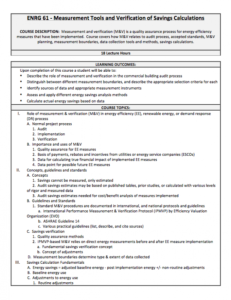ENRG 61: Measurement Tools and Verification of Savings Calculations

Program Description:
The Commercial Building Energy Analysis and Audits program at City College of San Francisco prepares students to conduct energy audits, evaluate building systems for efficiency, analyze energy data, and apply financial and business strategies in audit reporting. The program is divided into 15 modular courses designed for a community college level student. These courses are adaptable and can be selected, reorganized, or offered in a shorter format to suit individuals with experience in construction, architecture, HVAC, building operations, or mechanical engineering.
Course Description:
This course, from the BEST Center and City College of San Francisco, focuses on Measurement and Verification (M&V) as a quality assurance process for energy efficiency measures that have been implemented. The course asks students to consider how M&V relates to the audit process, accepted standards, M&V planning, measurement boundaries, data collection tools and methods, and savings calculations. In completing the course, students will be able to:
- Describe the role of measurement and verification in the commercial building audit process,
- Distinguish between different measurement boundaries, and describe the appropriate selection criteria for each,
- Identify sources of data and appropriate measurement instruments,
- Assess and apply different energy savings analysis methods, and
- Calculate actual energy savings based on data.
Course Contents:
Resources include a course outline and 8 PowerPoint presentations.
The 4-page course outline document includes a course description, learning outcomes, and a detailed course topics outline. Topics include: 1) the role of measurement and verification (M&V) in energy efficiency (EE); renewable energy; or demand response; concepts, guidelines and standards; savings calculation fundamentals; measurement boundary; savings calculation methods; selection of measurement boundary; sources of data and measurement instruments; and developing the M&V plan.
The PowerPoint presentations cover the topics detailed in the course outline.
For orientation purposes, viewers should begin with ENRG 61_Course Outline_cc.pdf, which offers a description of the course as well as an overview of topics covered through a course outline.
Below is a list of the files contained within the .zip attachment. The size of each file is included in parenthesis.
ENRG-61-M-V (19 files, 13.2 MB)
- Course Outline (ENRG 61_Course Outline.docx 23 KB)
- Course Outline (ENRG 61_Course Outline.pdf 356 KB)
- Role of Measurement and Verification (M&V) (MV A.pdf 375 KB)
- Role of Measurement and Verification (M&V) (MV A.ppt 492 KB)
- Definitions and Concepts (MV B.pdf 520 KB)
- Definitions and Concepts (MV B.ppt 425 KB)
- Savings Calculation Fundamentals (MV C.pdf 386 KB)
- Savings Calculation Fundamentals (MV C.ppt 391 KB)
- Measurement Boundary (MV D.pdf 543 KB)
- Measurement Boundary (MV D.ppt 406 KB)
- Savings Calculation Methods (MV E.pdf 1.7 MB)
- Savings Calculation Methods (MV E.ppt 876 KB)
- Application in IPMVP (MV F.pdf 335 KB)
- Application in IPMVP (MV F.ppt 400 KB)
- Sources of Data and Measurement (MV G.pdf 2 MB)
- Sources of Data and Measurement (MV G.ppt 3.2 MB)
- Developing the M&V Plan (MV H.pdf 336 KB)
- Developing the M&V Plan (MV H.ppt 386 KB)
About this Resource


Comments